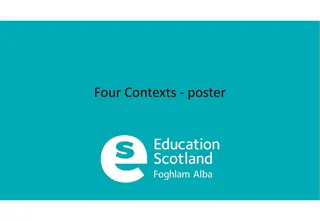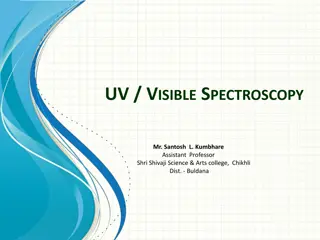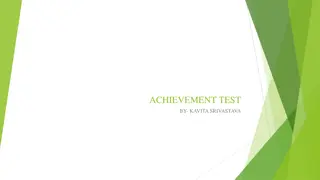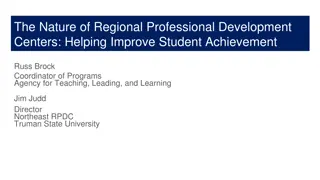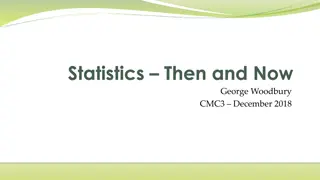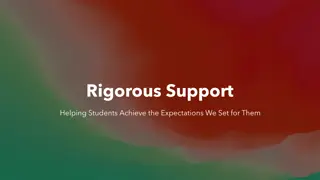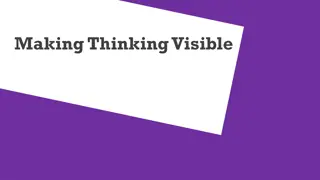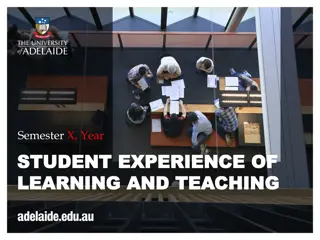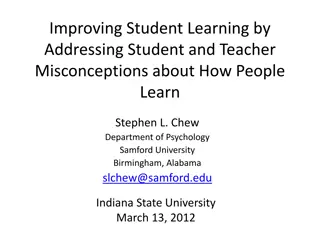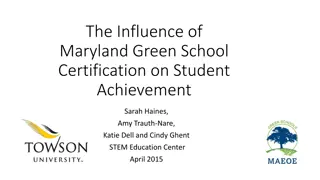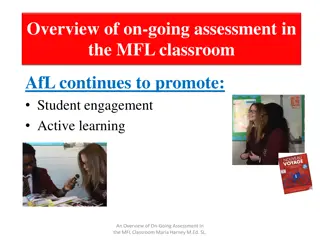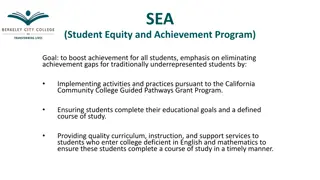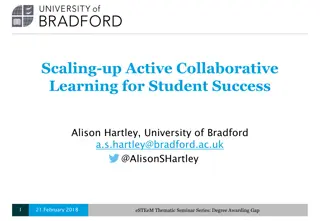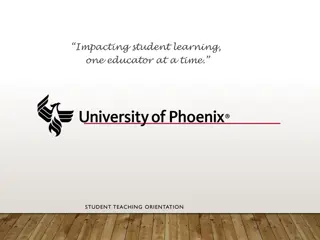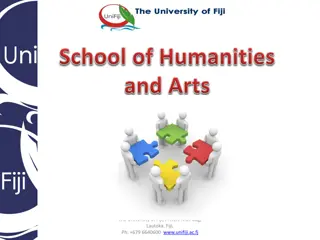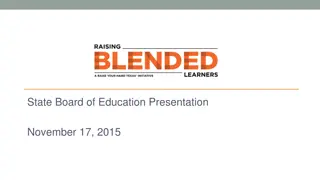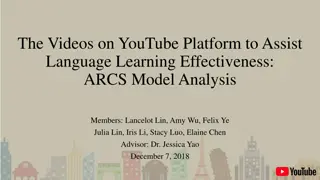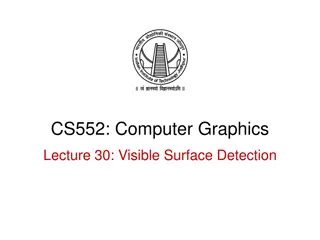Enhancing Student Achievement Through Visible Teaching and Learning
Visible Learning emphasizes making teaching and learning processes clear, increasing student achievement. John Hattie's research project highlights effective instructional strategies and the role of teachers in student success. Teachers play a pivotal role in fostering a conducive learning environment, being aware of student comprehension, and providing constructive feedback. The focus is on effective classroom practices and empowering students to become lifelong learners.
Download Presentation

Please find below an Image/Link to download the presentation.
The content on the website is provided AS IS for your information and personal use only. It may not be sold, licensed, or shared on other websites without obtaining consent from the author.If you encounter any issues during the download, it is possible that the publisher has removed the file from their server.
You are allowed to download the files provided on this website for personal or commercial use, subject to the condition that they are used lawfully. All files are the property of their respective owners.
The content on the website is provided AS IS for your information and personal use only. It may not be sold, licensed, or shared on other websites without obtaining consent from the author.
E N D
Presentation Transcript
Teaching and learning are VISIBLE- that is, when it is clear what teachers are teaching and what students are learning, student achievement increases.
Recall the teachers who truly made a difference to you when you were in school. Have a conversation with your table group. Share out a favorite story from your group.
Overview of Visible Learning Barometer of Effectiveness Rank instructional strategies Influences on student learning Reflections
John Hattie author of Visible Learning And Visible Learning For Teachers
Visible Learning is the result of John Hatties 15 year research project and a synthesis of over 800 meta-analyses* (over 50,000 studies) relating to the influences on achievement in school-aged students. It presents the largest ever collection of evidence-based research into what actually works in schools to improve learning (and what doesn't). *thinking about my thinking how do I learn the best?
According John Hattie Teachers have to begin planning with the END in mind Teachers becoming evaluators of their own teaching. Making teaching visible to the student as well, so that students learn to become their own teachers, an important component of becoming lifelong learners. There are practices that we know are effective in the classroom, and there are practices that we know are not. We do know what works. Focus on the factors that have the greatest impact on learning.
Teachers are the most powerful influences in learning. Teachers need to be directive, caring, and actively engaged in the process of teaching and learning. Teachers need to be aware of what students have understood and to construct meaningful experiences from this. They also need to have sufficient subject knowledge to provide meaningful and appropriate feedback to enable every student to move progressively through curriculum levels.
Teachers and students need to understand the teaching/learning path: Where are you going? How are you going and "Where to go next? It is not knowledge or ideas, but it is the learner's construction of this knowledge and ideas that is critical. Leaders and teachers need to create environments in which ERROR is welcomed as a learning opportunity and learners feel safe to explore knowledge and understanding.
Clear learning intentions Challenging success criteria Range of teaching strategies Creates problem-solving learning opportunities Know when students are not progressing Provide feedback Deep understanding about how their students learn best
Clear learning intentions Challenging success criteria Range of teaching strategies Creates problem-solving learning opportunities Know when students are not progressing Provide feedback Deep understanding about how their students learn best
Students in a Visible Learning Room Understand learning intentions Are challenged by success criteria Develop a range of learning strategies Know when they are not progressing Seek feedback Visibly teach themselves
Activity: On your own, write down the influences that you think have impacted student achievement in your classroom. As a team, discuss and chart the influences that have impacted student achievement in your grade level.
Greater than 0.4 = Zone of desired effects 0.15 to 0.4 = Teacher effects 0 to 0.15 = Developmental effects Less than 0 = Reverse effects
Acceleration Feedback Direct Instruction Small group learning Integrated curriculum programs Homework Individualized instruction Ability grouping Open vs. traditional classes Retention (holding back a year) Shifting schools
Acceleration 0.88 Feedback 0.73 Direct Instruction 0.59 Small group learning 0.49 Integrated curriculum programs 0.39 Homework 0.29 Individualized instruction 0.23 Ability grouping 0.12 Open vs. traditional classes 0.01 Retention (holding back a year) -0.16 Shifting schools -0.34
Shifting schools -0.34 Retention -0.16 Television -0.14 Summer vacation -.09
Distance education 0.09 Ability grouping 0.11
Extra-curricula programs 0.17 Family structure 0.18 Class size 0.21
Ability grouping for gifted students 0.30 Homework 0.31 Simulations 0.33
Enrichment of gifted 0.39 Integrated curriculum programs 0.39 Self-concept on achievement 0.43 Frequent/effects of testing 0.46 Early intervention 0.47 Motivation on learning 0.48
Small Group Learning 0.49 Concept mapping 0.57 Peer influences 0.53
Parental involvement 0.55 Peer tutoring 0.55 Goals challenging 0.56 Mastery learning 0.57 Home environment 0.57 Providing worked examples 0.57
Direct instruction 0.59 Time on task 0.59 Study skills 0.59 Acceleration of gifted 0.60
Self-reported grades 1.44 Piagetian programs 1.28 Providing formative evaluation 0.90 Acceleration 0.88 Classroom behavioral 0.80 Comprehensive interventions for learning disabled students 0.77 Teacher clarity 0.75 Reciprocal teaching 0.74 Feedback 0.73 Teacher-Student relationships 0.72
With a partner discuss these nine factors that influence student achievement Place them in order of how great you think their positive influence is (on average) Discuss why they might have this effect (5 minutes)
Expectations Mastery Learning Homework Challenge of Goals Feedback Class size Ability Grouping Peer Tutoring Teacher-Student Relationships
Effect Size Feedback 0.73 Teacher-Student Relationships 0.72 Mastery Learning 0.58 Challenge of Goals 0.56 Peer Tutoring 0.55 Expectations 0.43 Homework 0.29 Class size 0.21 Ability Grouping 0.12
1. Non-directivity 0.74 2. Empathy 0.68 3. Warmth 0.68 4. Encouragement of higher order thinking 0.60 5. Encouraging learning 0.48 6. Adapting to Learning 0.41 7. Genuineness 0.29 8. Learner-centered beliefs 0.10
Given these four strategies, for you, what is the most important point? Mastery Learning Expectations Setting goals Student-teacher relationships
When teachers SEE learning through the eyes of the student and When students SEE themselves as their own teachers.


